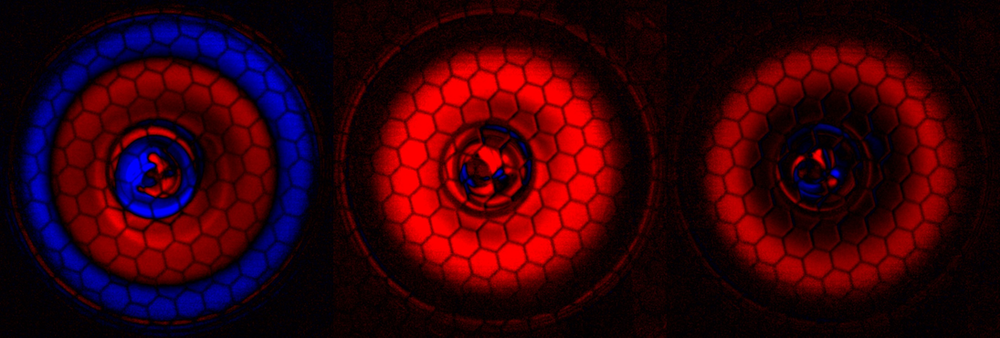Sound Waves Mimic Gravity
Sometimes a light bulb goes on—literally—and a scientific advance is made. Researchers studying an acoustic effect in high-powered light bulbs have developed a system that mimics the gravitational field around planets and stars [1]. The team demonstrated that sound waves in the bulb generate a force that pulls gas toward the bulb’s center. This gravity-like force causes the gas to move around in convection cycles that resemble fluid flows in the Sun and in giant planets. With further improvements, the system could be used to investigate convection behavior that is too difficult to simulate with computers.
In 2017, research on high-powered sulfur lamps revealed that sound waves could drive hot gas to ball up in the center of the bulbs [2]. The surprising phenomenon caught the attention of Seth Putterman’s acoustic group at the University of California, Los Angeles. The team studied the clumping and showed that it could be explained by the acoustic radiation force. This force is well known in acoustic levitation experiments, in which sound waves scattering off an object, such as a small bead, can exert a force (see Synopsis: Tossing and Turning). Putterman and his colleagues showed that, in the bulbs, this force acts not at the surface of an object where sound scatters, but throughout the gas, where density variations redirect the sound waves. “We knew that the force acts at a sharp interface between something solid and a gas,” says team member John Koulakis. “In the bulb, there’s no sharp interface—just variations—but there still is a force.”
In modeling this system, the team realized that, under certain approximations, the acoustic force is proportional to the density of the gas—in the same way that the gravitational force in a medium is proportional to the medium’s density. The ability to generate “acoustic gravity” in the lab could offer scientists a controllable system for studying difficult problems in geology and solar physics—such as the convective mechanisms that produce the magnetic fields on Earth and the Sun. With this motivation in mind, the team has now designed an experiment in which the acoustic force is spherically symmetric, like the gravitational field of a planet or star.
To create their analogue system, Putterman and colleagues filled a 3-cm-wide spherical glass shell with sulfur gas and heated the gas in the center to 4000 ºC using microwaves. By modulating this microwave signal, they were able to generate sound waves in a standing wave pattern that was spherically symmetric. According to the team’s model, in this experiment, the acoustic force points inward, at least for the outer region of the sphere. (The force points outward at the center of the sphere, but the team did not investigate this region.) The gravity-like acoustic force has a maximum strength that is 1000 times the gravitational force on Earth’s surface—meaning that the gas’s motion should be dominated by the acoustic gravity.
Video recordings of the sphere reveal complicated gas motion after the acoustic force is turned on. The researchers identified this motion as convective flow driven by the gas being heated near the center. As in a gaseous giant planet or in a star, hot clumps of gas “rise to the surface,” producing bright plumes. When these clumps reach the outer glass boundary, they lose their heat and sink back toward the center.
Researchers have previously produced planet-like convection with other gravity-mimicking forces, such as the dielectrophoretic force that arises in strong and oscillating electric fields. But these other forces were so weak that the experiments required a microgravity environment—such as that of an orbiting space lab—to detect the effects [3]. By contrast, the acoustic force is strong enough that the experiments can be carried out in a terrestrial lab.
The convection that the team observes is in a thermodynamic region that is far from planetary or stellar conditions. Reaching such conditions would be difficult, but the researchers have plans to raise the central temperature of their gas, which would let them explore thermodynamic regions that are currently beyond the capability of computer simulations. “While not on a planetary scale, our setup will drive tests of the accuracy with which spherical convection codes capture various key nonlinear processes,” Putterman says.
“It’s a pretty amazing experiment,” says convection modeler Nick Featherstone from the University of Colorado, Boulder. The experimental difficulties in reproducing spherically symmetric gravity have limited efforts to study the origin of solar and terrestrial magnetic fields, so the new setup is “a major step forward,” Featherstone says. “I suspect that over the coming years, it will lead to a transformation in the way we study planets and stars in the laboratory context.”
–Michael Schirber
Michael Schirber is a Corresponding Editor for Physics Magazine based in Lyon, France.
References
- J. P. Koulakis et al., “Thermal convection in a central force field mediated by sound,” Phys. Rev. Lett. 130, 034002 (2023).
- G. Courret et al., “On the plasma confinement by acoustic resonance,” Eur. Phys. J. D 71, 214 (2017).
- F. Zaussinger et al., “Rotating spherical gap convection in the GeoFlow International Space Station (ISS) experiment,” Phys. Rev. Fluids 5, 063502 (2020).





